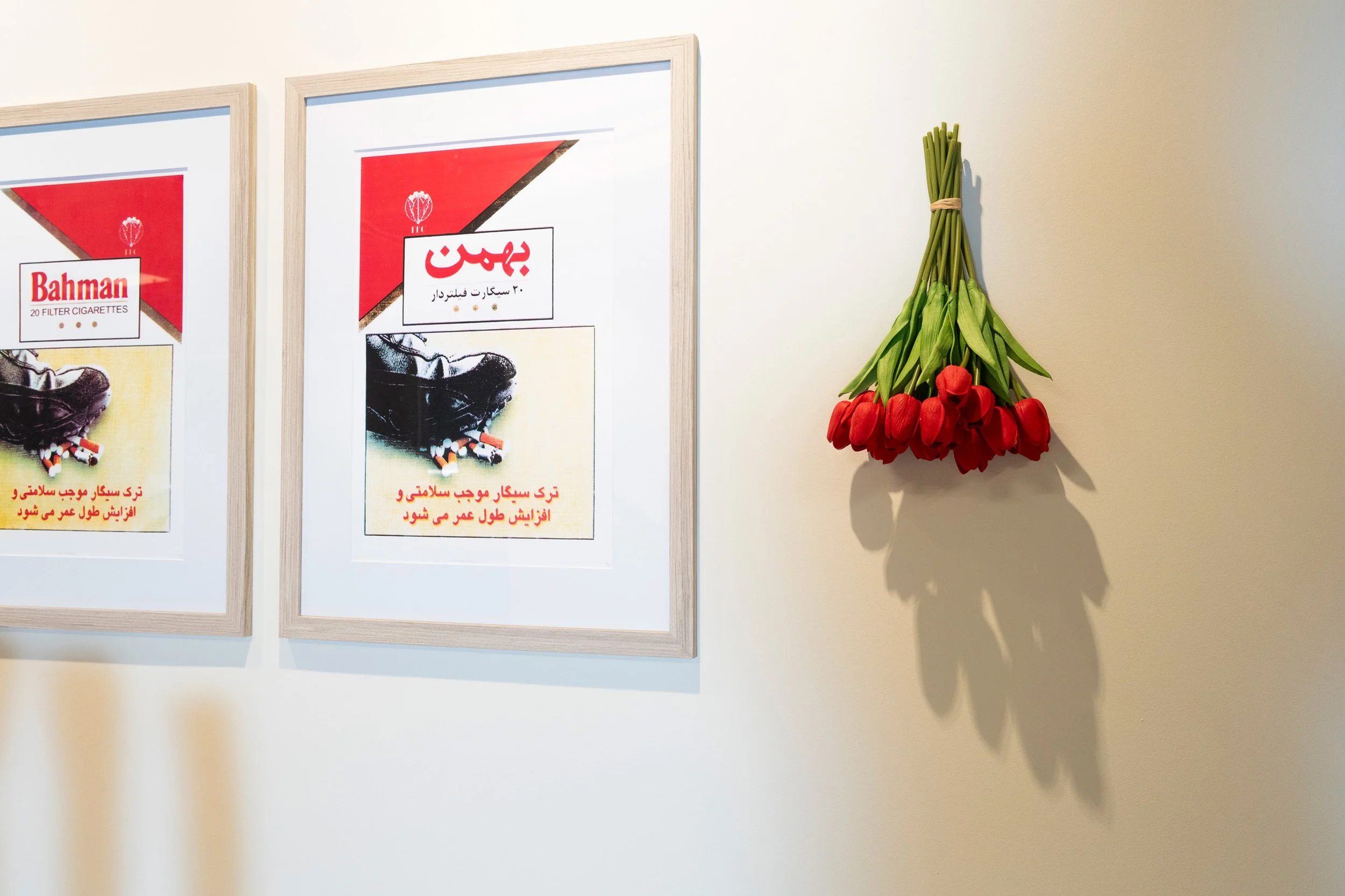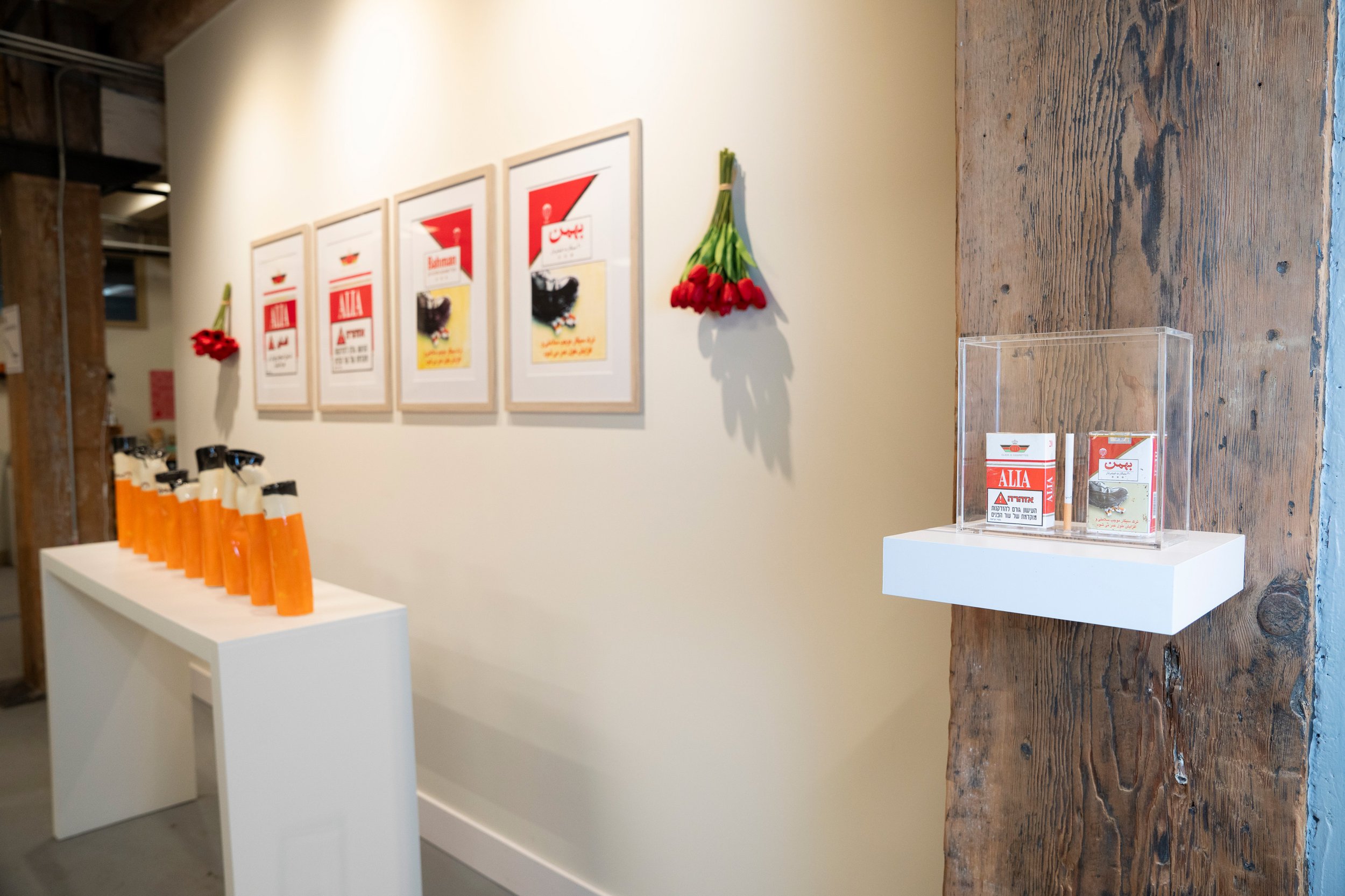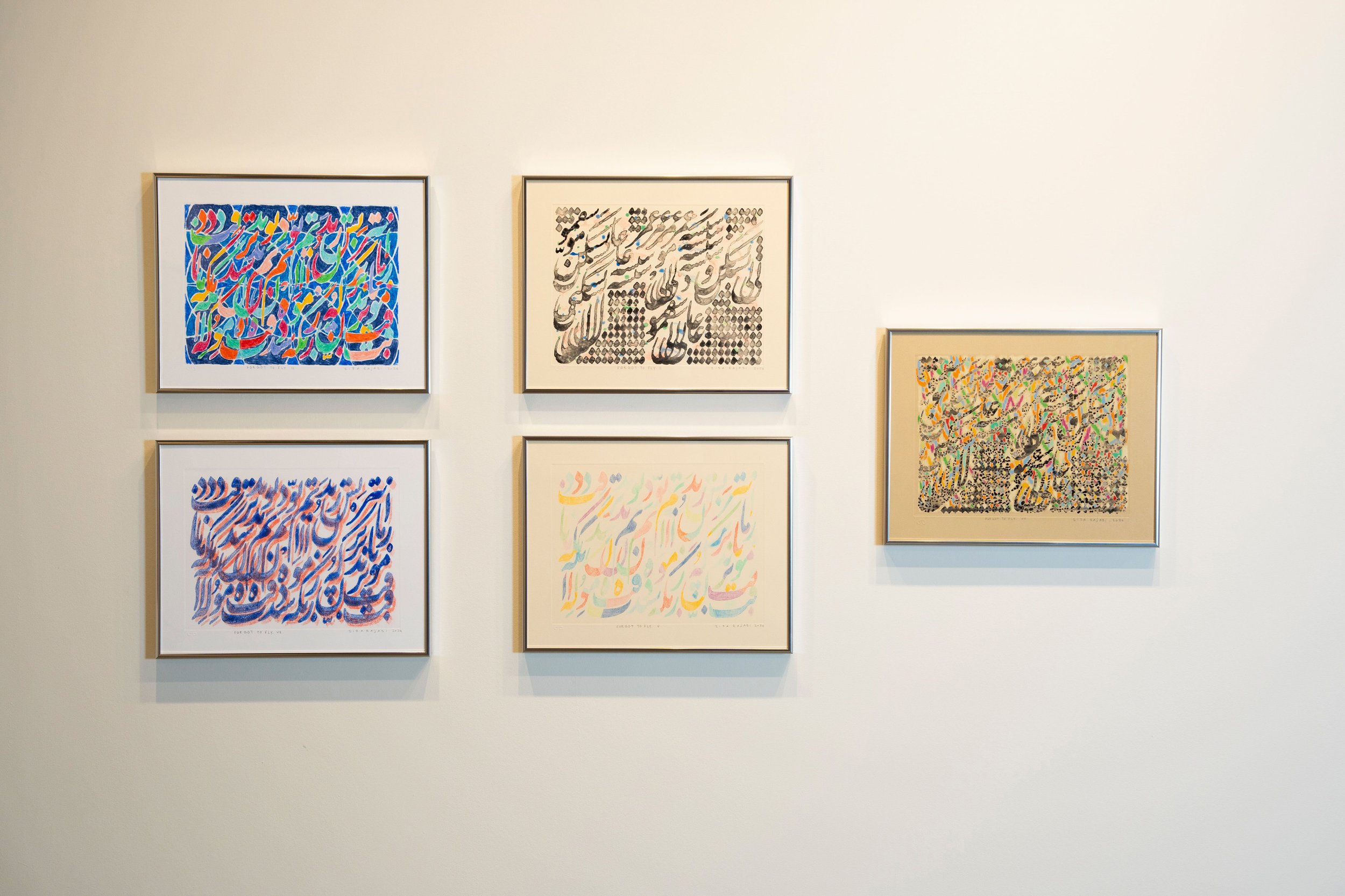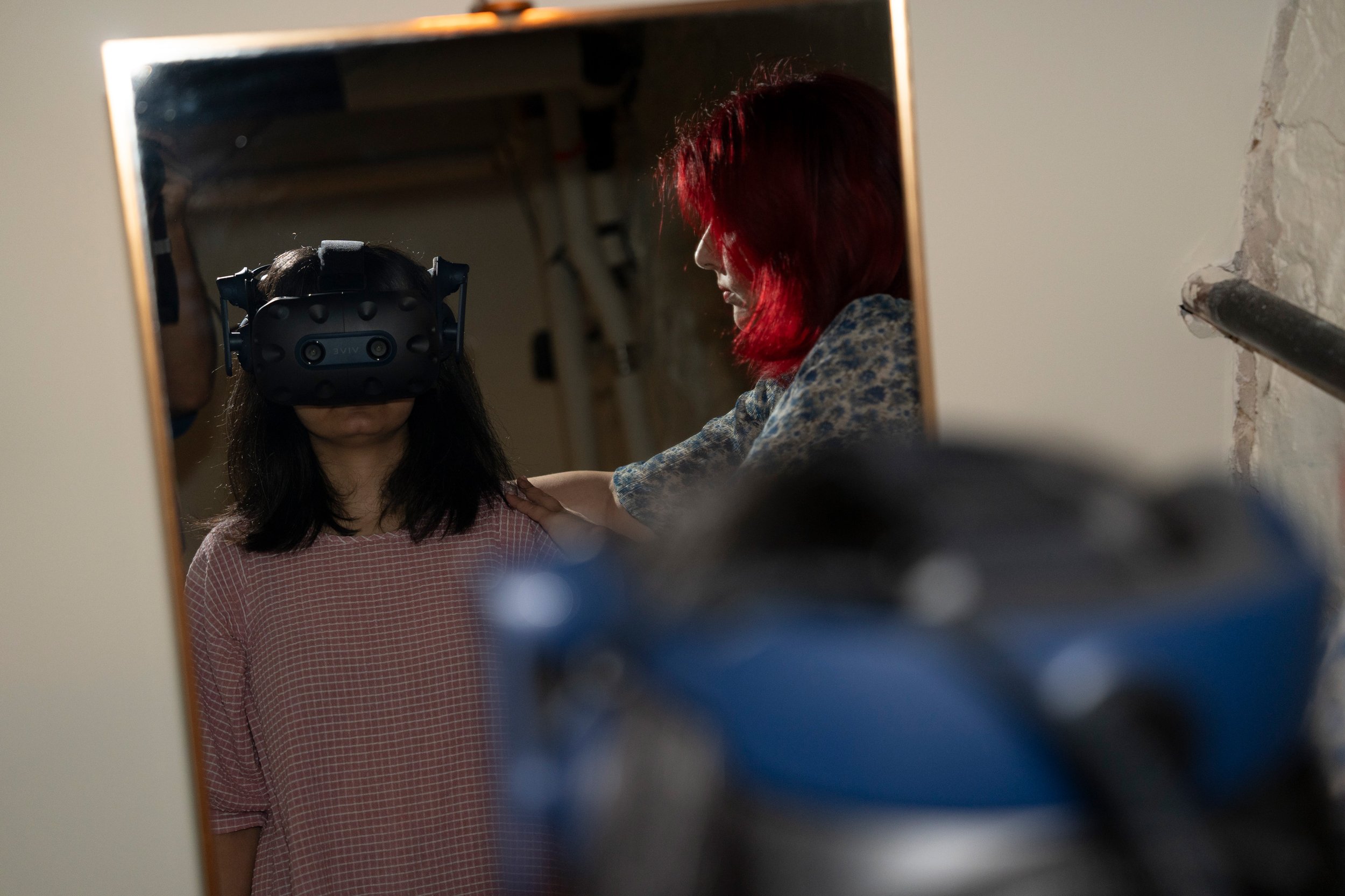So Far, So Close
Group Exhibition
Katayoun Amjadi, Shirin Ghoraishi, Ziba Rajabi
Q.Arma Underground Gallery, Sept 6-26, 2024
Opening reception and artist talk: Friday, Sept 6, 6-9 PM (Artists talk moderated by Aida Shahghasemi will be held on the day of the opening reception at 7:30-9:00 PM)
Closing Reception: Saturday, Sept 21, 3-5 PM
Q.Arma Underground Gallery
1224 Quincy Street NE, Minneapolis, MN 55413
The So Far, So Close exhibition explores the complicated experience of displacement from the motherland through themes of space, distance, and memory by Iranian female artists who reside outside of Iran by choice or by force.
Even though these artists have resided so far from their homeland for years, they feel so close to it, and distance has not diminished their love and care for it. Through the Persian language and Iranian culture, a part of their existence is defined by where they are from, regardless of where they take these temporal bodies. Meanwhile, they embrace and value their borderless life journey and cherish experiences that they have had as a result of a deliberate choice to live abroad and the opportunity to explore the unknown. Throughout years of living in the United States–despite how the politics of this country have treated them–they have grown to develop a sense of belonging to this land, creating a community with like-minded, colorful people and trying to make a temporary home out of it until it becomes permanent–if ever.
Centered around themes of low-art and high-art conversation; diasporic identity through the lens of history, memory, and nostalgia; storytelling via iconography and symbolism as means of communication; and the power of representation, Katayoun Amjadi’s interdisciplinary work spans through ceramics, installation, video, sculpture, writing, and social activism. While her work is a commentary on current global concerns, it further looks for historical traces of the human condition and probes the relationship between past and present, tradition and modernity, and the many types of identity woven through our collective history.
The iObject showcased in the So Far, So Close exhibition is a visual story of two souvenirs Amjadi has brought with her to Minneapolis from Tehran and Jerusalem. This installation consists of four panels of painting-silkscreening flanked by two additional wall pieces. In front of this arrangement, a pedestal displays multiple ceramic vases in the shape of cigarette packs for tulips, and a video poetry plays on a loop. This work is part of an ongoing series titled The Things We Bring, which explores how the objects we keep when moving as an immigrant or while living in diaspora are signifiers of our culture, ethnicity, or history; they become touchstones to our past; of places, we no longer inhabit yet want to keep close.
Fascinated by technology and its role in our world today, Shirin Ghoraishi’s research-based work involves science, technology, and interactive media, that centers around themes of space, memory, real and unreal, and the experience of living in between.
Her virtual-reality interactive work presented in the So Far, So Close exhibition delves into the interplay between reality, memory, and dreams, exploring how the psyche navigates these realms. It examines concepts of intentional and incidental forgetting to elucidate the mechanisms of our brain and neurotransmitters in the process of forgetting. Through this work, the boundary between the unreal and illustrations blurs, transforming into memories that can be recalled. In this interactive installation, Ghoraishi sources the imagery from vague memories that might have been made by her own mind or a reminiscence of the past. The artist instructs the audience on how to experience the work and then leads them through the installation. After experiencing the work, the audience exits the installation. This work of art is purely based on memory and the illusion of self, space, and time, highlighting a lack of certainty. My aim for the audience is to doubt and question our reality: what is an illusion, and what is a memory from the past? What information is structured, and what part of reality is altered? And how do we navigate it?
Working primarily with painting, drawing, and installation, Ziba Rajabi reconciles her relationship with where she comes from, Iran, and where she currently resides, the United States. She draws inspiration from Iranian architecture, book art, and Persian calligraphy to inform her compositions. In this series of works exhibited in the So Far So Close exhibition, through watercolor monotypes, she created prints, employing verses from Pop songs by Iranian female singers who lived and worked in exile after the 1979 revolution. The medium of printmaking metaphorically adds another layer of distance, while art and music bridge this gap and shorten this distance. During the 80s and 90s, the Islamic regime banned pop music, and the only art and music allowed were war propaganda. The only sources of Iranian dance music that would bring joy to birthdays, weddings, and parties were the smuggled tapes and VHS from Iranian artists in exile. Growing up in that era, she owes the happiness of their festivities and parties to these artists in exile. These works are an ode to them.
______
Katayoun Amjadi is an Iranian-born, Minneapolis-based artist, educator, and independent curator. In her work, she often considers the sociopolitical systems that shape our perceptions of Self and Other, such as language, religion, gender, politics, and nationalist ideologies. Amjadi blurs these boundaries and creates an off-balance, hybrid style that is slightly acerbic and a little bit tongue-in-cheek. Her art probes the relationship between past and present, tradition and modernity, and individual versus collective identity, and simultaneously seeks to spur discussion about our place in the temporal arc and the interwoven roots of our histories. Amjadi holds an MFA in ceramics and sculpture from the University of Minnesota Twin Cities and currently teaches in the Art Department at Normandale Community College in Bloomington, Minnesota. Her work has been exhibited in several group and solo exhibitions nationally and internationally, including at the Minnesota Museum of American Art (St. Paul, MN), Rochester Art Center (Rochester, MN), Weisman Art Museum (Minneapolis, MN), South Dakota Museum of Art (Brookings, SD), Des Moines Art Center (Des Moines, IA), The Soap Factory (Minneapolis, MN), University of St. Thomas (St. Paul, MN), Public Functionary (Minneapolis, MN), Beijing Film Academy (Beijing, China), Staatliche Akademie der Bildenden Künste Karlsruhe (Karlsruhe, Germany), and Haftsamar Gallery (Tehran, Iran) among others. Selected fellowships include MCAD-Jerome Emerging Artist (2020/2021), Artist Initiative Grants from the Minnesota State Arts Board (2015/2019), and Creative Individual Grant (2024). Amjadi co-runs a studio arts building and maintains a small ceramics business in the Q.arma Building in the northeast Minneapolis art district.
Shirin Ghoraishi, an Iranian-born artist based in Minneapolis, explores the intersections of space, psychology, power structures, technology, and science. Educated at the School of the Art Institute of Chicago and holding a Master’s degree in Visual Art from the Minneapolis College of Art and Design, Shirin’s practice as both an artist and curator challenges and redefines the boundaries of perception and reality.
Ziba Rajabi (b.1988, Tehran, Iran) received her MFA from the University of Arkansas, Fayetteville, and her BFA from the Sooreh University, Tehran, Iran. Her primary practice is focused on painting, drawing, and fabric-based installation. She is the recipient of the Jerome Foundation Mid-Career Artists Fellowship and the Artist 360 Grant, a program sponsored by the Mid-America Arts Alliance. Her work has been included in a number of exhibitions, nationally and internationally, such as Crystal Bridges Museum of American Art; AR, CICA Museum; South Korea; Masur Museum; LA; 21C Museum, AR; Araan Gallery, Iran; The II Platform, UK, among many others. She has been an artist in residence at Vermont Studio Center, Terrain Residency, and Anderson Ranch Arts Center.
*This exhibition is organized by Ziba Rajabi and sponsored by the Twin Cities Iranian Culture Collective.
خیلی دور، خیلی نزدیک نمایشگاه گروهی است از هنرمندان زن ایرانی که به انتخاب یا به اجبار خارج از ایران سکونت دارند. آثار هنری ارائه شده در این نمایشگاه حول محور تجربه زندگی خارج از مرزهای فرهنگی و سیاسی ایران میگردد که از دریچه مفاهیمی مانند دوری، جدا افتادگی، و خاطره این موضوع را بررسی میکنند.
با وجود اینکه این هنرمندان سالهاست دور از وطن زیستهاند، اما این واقعیت خدشهای بر علاقه و اهمیتشان به سرزمین مادری وارد نکردهاست و تو گویی بخشی از وجودشان از بنیان با زبان و فرهنگ ایرانی شکل گرفته است. اینکه این کالبد فانی را کجا ببرند تاثیری بر هویت فرهنگیشان ندارد. با این حال، در برههای از زندگی این هنرمندان تصمیمی آگاهانه بر ترک مملکت و روبرویی با ناشناختهها گرفتند و اکنون امکان زندگیای بیمرز و تجربیات ارزنده حاصل از آن انتخاب را ارج مینهند. در طی سالیان متمادی زندگی در ایالات متحده، علیرغم تجربیات ناخوشایند از سیاستهای این کشور، این هنرمندان به مرور حس تعلقی به این سرزمین جدید پیدا کرده و از میان مردمان همفکر که از گوشه گوشه این کره آبی به گرد هم آمدهاند جامعه کوچکی برای خود دست و پا کردهاند و در تلاشند که خانهای موقتی اینجا بسازند، شاید که دائمی شود−اگر بشود.


















